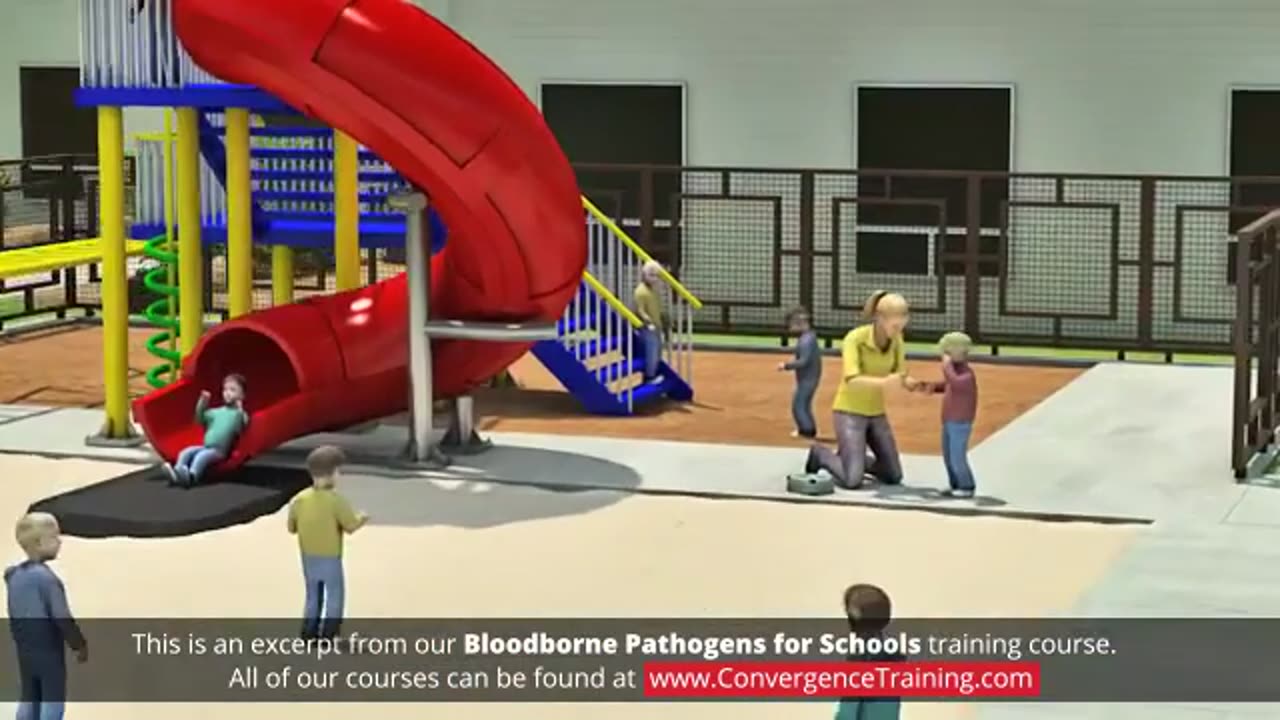Premium Only Content

Bloodborne Pathogens for Schools
### **Bloodborne Pathogens in Schools**
In schools, the risk of exposure to bloodborne pathogens is generally lower compared to healthcare settings but still exists, especially for teachers, custodians, nurses, and other staff who may come into contact with blood or bodily fluids.
### **Common Scenarios in Schools**
1. **Injuries on the Playground or in Classrooms**: Cuts, scrapes, or nosebleeds.
2. **Sports Injuries**: Contact sports can result in bleeding.
3. **Assisting Students with Medical Needs**: Handling diabetic care, bloody tissues, or assisting students with special health conditions.
4. **Handling Sharps**: Needles (diabetic care, epinephrine pens) or broken glass.
---
### **Risks for Staff and Students**
Bloodborne pathogens of concern include:
- **Hepatitis B (HBV)**
- **Hepatitis C (HCV)**
- **Human Immunodeficiency Virus (HIV)**
These can be transmitted if blood or bodily fluids come into contact with broken skin, mucous membranes (eyes, nose, mouth), or through sharps injuries.
---
### **Prevention Measures for Schools**
1. **Universal Precautions**:
- Treat all blood and bodily fluids as potentially infectious.
- Avoid direct contact with blood.
2. **Personal Protective Equipment (PPE)**:
- Staff should use gloves, face shields, or masks when handling blood or bodily fluids.
3. **Safe Cleanup Practices**:
- Use absorbent materials, disinfectants, and proper disposal containers (like biohazard bags or sharps containers).
- Immediately clean areas contaminated with blood using approved disinfectants.
4. **Proper Hand Hygiene**:
- Wash hands thoroughly with soap and water after handling blood or bodily fluids.
5. **Exposure Control Plan (ECP)**:
- Schools should develop an ECP that outlines:
- What to do in case of exposure.
- Who to contact.
- Post-exposure evaluation procedures.
6. **Training and Education**:
- Schools should provide **annual bloodborne pathogen training** for staff.
- Training should cover universal precautions, PPE use, and emergency response.
7. **Hepatitis B Vaccination**:
- Employers are required (per OSHA guidelines) to offer free Hepatitis B vaccinations to staff with potential exposure risks.
---
### **Steps for Handling Bloodborne Pathogen Exposure in Schools**
If a staff member or student is exposed:
1. **Immediate Response**:
- Wash the affected area with soap and water.
- Flush eyes, nose, or mouth if exposed.
2. **Report the Incident**:
- Notify the school nurse or administration.
3. **Seek Medical Attention**:
- Post-exposure evaluation, treatment, and follow-up testing (if needed).
---
### **Key Roles in Schools**
- **School Nurses**: Educate staff and oversee proper medical procedures.
- **Custodial Staff**: Ensure proper cleaning and disinfection of contaminated areas.
- **Teachers and Coaches**: Respond quickly to student injuries while following universal precautions.
Would you like resources for creating an **exposure control plan**, training materials, or posters for school staff?
-
 3:14:33
3:14:33
Joe Donuts Gaming
4 hours ago🟢 Live : Christmas is Here!! | Fortnite, Caroling, Light Tours and Donos !!
17K6 -
 LIVE
LIVE
CLUJ
3 hours agoCHRISTMAS EVENING HYPE!! LETS HAVE FUN GAMING!!
690 watching -
![I AM FINALLY BACK :: PUBG: BATTLEGROUNDS :: RUMBLE NOW HAS GIFTED SUBS!!! [Merry Christmas] {18+}](https://1a-1791.com/video/fwe1/22/s8/1/e/f/C/6/efC6v.0kob-small-I-AM-FINALLY-BACK-PUBG-BATT.jpg) LIVE
LIVE
a12cat34dog
5 hours agoI AM FINALLY BACK :: PUBG: BATTLEGROUNDS :: RUMBLE NOW HAS GIFTED SUBS!!! [Merry Christmas] {18+}
145 watching -
 3:55:42
3:55:42
STARM1X16
5 hours agoMerry Christmas Fortnite
22.7K2 -
 2:45:33
2:45:33
Sgtfinesse
5 hours agoMerry Christmas Night
30.5K6 -
 LIVE
LIVE
tacetmort3m
21 hours ago🔴 LIVE - (MERRY CHRISTMAS) TIME TO SPREAD DEMOCRACY - HELLDIVERS 2 OMENS OF TYRANNY
58 watching -
 12:42
12:42
Cooking with Gruel
19 hours agoBrown Butter Trifle with Salted Caramel and Cinnamon Apple
10.1K3 -
 2:46
2:46
BIG NEM
8 hours agoDiscovering RAKIJA: The Holy Liquer of the Balkans
8.05K2 -
 1:11:38
1:11:38
Film Threat
13 hours agoCHRISTMAS DAY CHILL STREAM WITH CHRIS GORE | Hollywood on the Rocks
131K24 -
 14:22:40
14:22:40
The Quartering
1 day agoYule Log Christmas MAGA Edition With Memes! Come Hang Out!
221K29